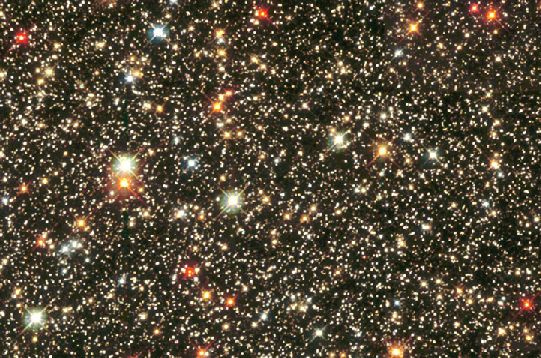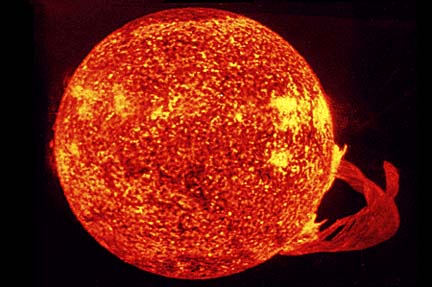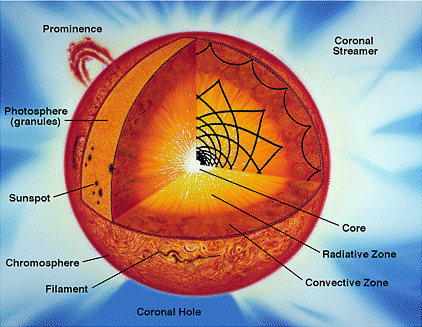Space EnvironmentWhat is in space? |
Basically, stars are big exploding balls of gas, mostly hydrogen and helium. Our nearest star, the Sun, is so hot that the huge amount of hydrogen is undergoing a constant star-wide nuclear reaction, like in a hydrogen bomb. Even though it is constantly exploding in a nuclear reaction, the Sun and other stars are so large and have so much matter in them that it will take billions of years for the explosion to use all the "fuel" in the star. The huge reactions taking place in stars are constantly releasing energy (called electromagnetic radiation) into the universe, which is why we can see them and find them on radio telescopes such as the ones in the Deep Space Network (DSN). Stars, including the Sun, also send out a solar wind and burst out occasional solar flares.

The Saggitarius Star Cloud, found at the center of our galaxy. Star color
is linked to temperature. A relatively cool, yellow star like our Sun would
seem dim in this photograph. Hubble Space Telescope Image from the Astronomy
Picture of the Day Archive. http://antwrp.gsfc.nasa.gov/apod/ap990113.html
Scientists think that the core of the Sun is a 15 million degree Celsius plasma, a soup of electrons and protons that are stripped from hydrogen atoms. This "soup," called plasma, makes up 90 percent of the Sun. Every second, thousands of protons in the Sun's core collide with other protons to produce helium nuclei in a nuclear fusion reaction that releases energy. Just outside the core, energy moves outward by a process called radiation. Closer to the surface, the energy moves out by a process called convection - hot gases rise, cool, and sink back down again. As these masses of gas move, they push off of each other causing "Sun-quakes." These make the material in the Sun vibrate. These Sun-quakes help scientists determine the Sun's internal structure and the processes occurring at different locations underneath the Sun's surface.

NASA Photo of the Sun taken by Skylab in 1973. From the Astronomy Piture
of the Day Archives, http://antwrp.gsfc.nasa.gov/apod/ap960916.html

This drawing shows the major features of the Sun. The Sun actually consists
of 90% hydrogen and a mixture of other gases. In diameter, it is over 100 times
bigger than the Earth. From the Education and Public Outreach Page of the
Solar and Heliospheric Observatory (SOHO) project at NASA. http://sohowww.nascom.nasa.gov/explore/img/mdigraphic.gif
![]()
What is in space besides planets and stars?
What is energy?
What is plasma?
What is DSN?
How does heat move?
What is heat?
![]()
What is electromagnetic radiation?
What role does the Sun play in space missions like DS1's?
More about radio waves and electromagnetic radiation
Will DS1 get heated directly by the Sun?
Does heat travel differently in space than it does on Earth?
![]()
Why don't we receive light from all the stars in the universe?
What is solar wind?
What is a solar flare?
How do you make a radio wave?
Where does energy come from and go?
What makes EM radiation?
![]()